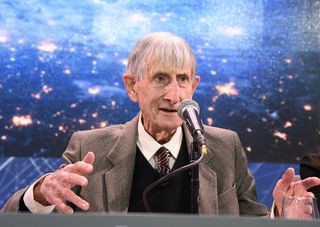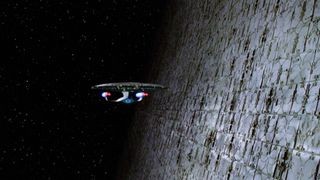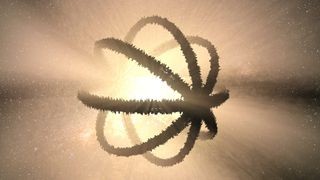What Is A Dyson Sphere? This hypothetical megastructure, designed to encircle a star and harness its energy, has captivated scientists and science fiction enthusiasts alike. At WHAT.EDU.VN, we provide clear answers to your questions about the universe and beyond, including the fascinating concept of a Dyson sphere. Discover the details of Dyson spheres, Dyson swarms, and related astro-engineering projects, and don’t hesitate to ask us any question you have for free.
1. The Dyson Sphere Theory Explained
The underlying concept of a Dyson sphere involves capturing the maximum amount of energy emitted by a star. The Earth receives only a tiny fraction of the Sun’s total energy output, approximately 1,361 watts per square meter. The Sun radiates an astounding 3.86 x 10^26 watts every second.
A technologically advanced civilization could potentially construct a Dyson sphere, a vast network of solar energy collectors, fully enclosing a star to harness its entire energy output.
This idea leads to the Kardashev scale, which classifies civilizations based on their energy consumption.
- Type I: Utilizes all energy available on a single planet (around 10^16 watts per second).
- Type II: Harnesses all the energy from a star (approximately 10^26 watts per second), achievable with a Dyson sphere.
- Type III: Controls the energy of an entire galaxy (around 10^36 watts per second), potentially through Dyson spheres around every star and energy extraction from the central supermassive black hole.
Currently, humanity is estimated to be around a Type 0.7449 civilization, meaning we haven’t fully mastered the energy resources even on our own planet.
2. Frequently Asked Questions About Dyson Spheres
| Question | Answer |
|---|---|
| What is a Dyson sphere? | Freeman Dyson proposed in 1960 that advanced alien civilizations might construct solar energy collectors surrounding their star, detectable by the waste heat emitted. |
| Is building a Dyson sphere possible? | Theoretically, yes, but it would require immense resources, advanced engineering, and a significant amount of time, posing considerable challenges. |
| How much would a Dyson sphere cost? | Building a Dyson sphere would necessitate dismantling an entire planet for raw materials, making it difficult to assign a monetary cost. However, the energy generated should eventually offset these costs and more. |




3. Who Conceived the Idea of the Dyson Sphere?
Freeman Dyson, a renowned physicist, originated the concept of Dyson spheres. His 1960 publication in Science was inspired by Olaf Stapledon’s 1937 science fiction novel “Star Maker.” Dyson sought a method to detect technologically advanced civilizations that might not want to communicate. He theorized that looking for massive artificial megastructures would be a viable approach.
Dyson’s career spanned diverse areas, including quantum electrodynamics, nuclear spacecraft propulsion (Project Orion), the origins of life, condensed matter physics, and mathematics.
4. Dyson Spheres in Science Fiction: “Star Trek”
Dyson spheres and similar megastructures have appeared in numerous science fiction works, but the 1992 “Star Trek: The Next Generation” episode “Relics” is among the most famous. In this episode, the Enterprise-D crew discovers a crashed Federation starship on a Dyson sphere’s surface, where they find Montgomery Scott (Scotty) preserved in the ship’s transporter buffers. The Enterprise becomes trapped inside the sphere and Scotty and Geordi La Forge must rescue them.
The episode inaccurately depicts the Dyson sphere as a solid shell. A solid shell would be mechanically unstable and vulnerable to impacts. Gravitational disturbances could also cause it to collide with the star.
Dyson later clarified that a “Dyson swarm,” consisting of numerous small solar energy collectors, would be more practical. Damaged sections would not compromise the entire structure, and individual collectors could use thrusters to maintain their positions.
5. Constructing a Dyson Swarm: A Step-by-Step Process
Dyson’s original paper estimated that building a Dyson swarm would require dismantling a planet the size of Jupiter to gather sufficient raw materials.
Astronomer Stuart Armstrong suggested dismantling Mercury as a more feasible option. The planet contains enough material to create a spherical swarm of solar collectors in Mercury’s orbit, with each collector weighing approximately 245 grams per square meter.
The construction could begin small, with the initial solar array generating power for mining asteroids to build more arrays. This would then provide energy to mine and dismantle Mercury. Each phase of construction would become exponential, driven by the growth of solar energy collection and mining.
6. Detecting Dyson Swarms: Identifying Waste Heat
Dyson’s primary goal was to find a way to detect advanced alien civilizations that aren’t trying to communicate. How can we detect a Dyson swarm that has blocked and absorbed all of the light from its star?
The second law of thermodynamics dictates that heat flows from hotter to colder objects. Solar collectors in a Dyson swarm would absorb radiation, becoming hotter than the surrounding space. They would then emit thermal energy (waste heat) into the colder space to prevent overheating.
A Dyson swarm should radiate in the thermal infrared spectrum. Astronomers need to identify objects in deep space emitting anomalous amounts of infrared radiation. However, natural objects such as red stars producing dust, planetary nebulas, and distant dusty galaxies can mimic this signature. Therefore, potential Dyson swarms must be thoroughly investigated to rule out natural explanations.
7. Have We Discovered Any Alien Megastructures?
Initial searches for Dyson swarms were conducted in the 1980s using data from the Infrared Astronomical Satellite (IRAS). In 2009, Richard Carrigan reanalyzed IRAS data, identifying 16 infrared sources worthy of further investigation, while acknowledging they were likely natural phenomena.
Project Hephaistos, using machine learning, sifted through 5 million objects in NASA’s Wide-field Infrared Survey Explorer (WISE), the European Space Agency’s Gaia mission, and the Two Micron All-Sky Survey, revealing seven candidate Dyson swarms with excess infrared emission. These would be partial swarms only partially surrounding their stars.
However, these candidates were later refuted by another group. They showed that at least some of the candidates are very close in the sky to some dusty background galaxies that have strong infrared emissions. Meanwhile, another survey of the same data found 53 candidates with interesting infrared emissions. Nevertheless, in all of these cases, natural phenomena are the most likely explanation and must be ruled out before anything is declared a Dyson swarm.
A notable example is Boyajian’s star (Tabby’s star or KIC 8462852), discovered by Tabetha Boyajian. This star exhibits unusual transits, suggesting a swarm of objects orbiting it. At times, 22% of the star’s light was blocked, compared to the 1% blockage caused by a Jupiter-sized planet.
Initial speculation suggested an alien megastructure, such as a partial Dyson swarm, might be responsible. Ultimately, the light dips were attributed to clouds of dust, possibly from an evaporating exomoon or an exocomet.
Even if our galaxy lacks alien civilizations building Dyson swarms, there are trillions of other galaxies in the universe. A galaxy-spanning civilization with Dyson swarms around every star would be classified as a Kardashev Type III civilization. A WISE survey failed to find any such galaxies, but left open the possibility of galaxies where only a fraction of the stars have Dyson swarms.
It’s also possible that aliens might not build Dyson swarms at all. They may be too resource-intensive or time-consuming, or perhaps infinite growth through energy consumption isn’t their goal. The Dyson swarm concept is, after all, a human idea.
8. Q&A with Dyson Sphere Expert Erik Zackrisson
Erik Zackrisson, an associate professor at Uppsala University in Sweden, discusses his work with Project Hephaistos, which searches for Dyson swarms.
Q: Project Hephaistos identified seven partial Dyson swarm candidates with unusual infrared excess. What are the next steps in verifying them?
Erik Zackrisson: We have optical spectra from follow-up observations for some candidates, suggesting they are normal red dwarfs without signs of youth that could explain the infrared excess. New mid-infrared imaging with the James Webb Space Telescope (JWST) or sub-millimeter maps from ALMA could reveal if we are seeing a single object or a superposition of two, with the infrared excess coming from a background object.
Mid-infrared spectroscopy is needed to determine the nature of the infrared excess, assuming the optical and mid-infrared flux comes from the same object. Dust would show emission features reflecting its composition, while a Dyson sphere would show pure continuum radiation. JWST’s Mid-Infrared Instrument would be perfect for this.
Q: A rebuttal paper suggested the candidates might be background contamination from dusty galaxies. Do you agree?
Erik Zackrisson: I completely agree for cases where radio is detected. The situation is less clear-cut for cases without a detected radio source.
Q: In 2018, you wrote that a star with a Dyson swarm might appear farther away due to its red color compared to its parallax-measured distance, and Gaia could find these mismatches. Could this help with the candidates found by Project Hephaistos?
Erik Zackrisson: Additional diagnostics beyond infrared excess would be helpful. However, the distance mismatch diagnostic only works for Dyson swarms with very high covering fractions, making it less useful for our current candidates.
Q: Dyson swarm searches look for specific engineering forms. Could we be missing other technosignatures by not knowing what ET might build, and could simply looking for deviations from natural laws be a better approach?
Erik Zackrisson: Looking for outliers in large datasets could probe extreme astrophysics, new phenomena, and artificial astro-engineering. However, most outliers are due to faulty data, making it challenging to find truly interesting anomalies.
9. Further Resources on Dyson Spheres
- Anders Sandberg’s Dyson Sphere FAQ: Offers insights into Dyson sphere construction and properties.
- NASA’s Technosignatures Investment: Explores NASA’s commitment to searching for technosignatures, including Dyson swarms.
- NASA’s WISE Mission History: Details the Wide-field Infrared Survey Explorer mission, used in Dyson swarm searches.
10. References
- Solar Irradiance, NASA, 2018, https://sunclimate.gsfc.nasa.gov/article/solar-irradiance
- John Kennewell and Andrew McDonald, The Solar Constant, Australian Space Weather Forecasting Centre, https://www.sws.bom.gov.au/Educational/2/1/12
- Robert H. Gray, The Extended Kardashev Scale, The Astronomical Journal, 159, 228, 23 April 2020, https://iopscience.iop.org/article/10.3847/1538-3881/ab792b
- N. S. Kardashev, Soviet Astronomy–AJ, 8, 2, Sept–Oct 1964, https://adsabs.harvard.edu/full/1964SvA…..8..217K
- Antong Zhang, Jiani Yang, Yangcheng Luo and Siteng Fan, Forecasting the Progression of Human Civilization on the Kardashev Scale through 2060 With a Machine Learning Approach, Scientific Reports, 13, 11305 (2023) https://www.nature.com/articles/s41598-023-38351-y
- Freeman J. Dyson, Search for Artificial Stellar Sources of Infrared Radiation, Science, 131, 3414, pp. 1667–1668, 3 June 1960, https://www.science.org/doi/10.1126/science.131.3414.1667
- Austin A. Morris, ‘Maker of Patterns: An Interview with Freeman Dyson’ University of Edinburgh, 2017 https://blogs.ed.ac.uk/physics-astronomy/wp-content/uploads/sites/180/2018/11/Interview-with-Freeman-Dyson.pdf
- George Dyson, ‘Freeman John Dyson, 15 December 1913–28 February 2020’, Biographical Memoirs of Fellows of the Royal Society, 1 June 2022, https://royalsocietypublishing.org/doi/10.1098/rsbm.2021.0050
- Star Trek: The Next Generation — Relics, IMDb, https://www.imdb.com/title/tt0708764/
- Jack Smith, ‘Review and Viability of a Dyson Swarm as a Form of Dyson Sphere’, Physica Scripta, November 2022, https://iopscience.iop.org/article/10.1088/1402-4896/ac9e78
- Freeman J. Dyson, ‘Response: Artificial Biosphere’, Science, Vol 132, Issue 3421, pp 252–253, 22 July 1960, https://www.science.org/doi/10.1126/science.132.3421.252.b
- Stuart Armstrong, ‘Von Neumann Probes, Dyson Spheres, Exploratory Engineering and the Fermi Paradox’, YouTube, 2012, https://www.youtube.com/watch?v=zQTfuI-9jIo
- Second Law of Thermodynamics, NASA Glenn, May 2021, https://www.grc.nasa.gov/www/BGH/thermo2.html
- Jason T. Wright, ‘Application of the Thermodynamics of Radiation to Dyson Spheres as Work Extractors and Computational Engines and Their Observational Consequences’ The Astrophysical Journal, 956, 34, 2023, https://iopscience.iop.org/article/10.3847/1538-4357/acf44f
- Jason T. Wright, ‘Dyson spheres’, Serbian Astronomical Journal, No. 200, 1–18 (2020), https://saj.matf.bg.ac.rs/200/pdf/001-018.pdf
- Richard A. Carrigan, ‘IRAS-Based Whole-Sky Upper Limit on Dyson Spheres’, The Astrophysical Journal, 698, pp2075–2086 (2009), https://iopscience.iop.org/article/10.1088/0004-637X/698/2/2075/pdf
- Matías Suazo et al, ‘Project Hephaistos — II. Dyson sphere candidates from Gaia DR3, 2MASS, and WISE‘, Monthly Notices of the Royal Astronomical Society, Vol 531, issue 1, pp695–707, (2024) https://academic.oup.com/mnras/article/531/1/695/7665761
- Tongtian Ren, Michael A. Garrett, Andrew P. V. Siemion, ‘Background Contamination of the Project Hephaistos Dyson Spheres Candidates’, Research Notes bof the AAS, 8, 145, (2024) https://iopscience.iop.org/article/10.3847/2515-5172/ad5017
- Gabrielle Contardo and David Hogg, ‘A Data-Driven Search For Mid-Infrared Excesses Among Five Million Main-Sequence FGK Stars’, 2024, https://arxiv.org/abs/2403.18941
- T. S. Boyajian et al, ‘Planet Hunters X. KIC 8462852 – Where’s the Flux?’, Monthly Notices of the Royal Astronomical Society, 457, 4 (2016),’https://academic.oup.com/mnras/article/457/4/3988/2589003
- Bradley E. Schaefer et al, ‘The KIC 8462852 light curve from 2015.75 to 2018.18 shows a variable secular decline’, Monthly Notices of the Royal Astronomical Society, 481, 2 (2018), https://academic.oup.com/mnras/article/481/2/2235/5045268
- Miguel A. S. Martinez et al, ‘Orphaned exomoons: Tidal detachment and evaporation following an exoplanet–star collision’, Monthly Notices of the Royal Astronomical Society, 489, 4 (2019), https://academic.oup.com/mnras/article/489/4/5119/5561511
- Steven D. Young and Mark C. Wyatt, ‘The eccentric Koza–Lidov mechanism as the cause of exocomet transits of KIC 8462852’, Monthly Notices of the Royal Astronomical Society, 527, 3, (2024) https://academic.oup.com/mnras/article/527/3/5244/7285819
- Christopher Conselice et al,’The Evolution of Galaxy Number Density at z<8 and its Implications’, The Astrophysical Journal, 830, 83 (2016), https://iopscience.iop.org/article/10.3847/0004-637X/830/2/83
- Jason T. Wright at al, ‘The Ĝ Infrared Search for Extraterrestrial Civilizations with Large Energy Supplies II: Framework, Strategy and First Result’, The Astrophysical Journal, 792, 1 (2014), https://iopscience.iop.org/article/10.1088/0004-637X/792/1/27/meta
- Erik Zackrisson et al, ‘SETI with Gaia: The Observational Signatures of Nearly Complete Dyson Spheres’, The Astrophysical Journal, 862, 1 (2018), https://iopscience.iop.org/article/10.3847/1538-4357/aac386
Are you still curious about Dyson spheres or other space-related topics? Don’t hesitate to ask your questions at WHAT.EDU.VN. Our community of experts is ready to provide clear, concise, and free answers. Contact us at 888 Question City Plaza, Seattle, WA 98101, United States, or via Whatsapp at +1 (206) 555-7890. Visit what.edu.vn today and unlock the mysteries of the universe.
